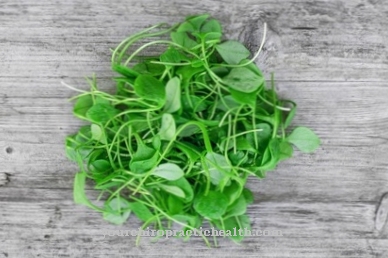Walnuts besides hazelnuts, are the most well-known and most widely used nut fruits among Germans. The walnut, which is popular around the world, is valued as a delicious snack and baking ingredient, among other things. But it is also considered a “superfood” with excellent health-promoting properties.
What you should know about the walnut

The commodity sold as “walnut” is usually the fruit of the real walnut tree (Juglans regia). Fruits of closely related species such as black nuts or butternuts as well as various hybrids as walnuts are also rarely on the market. The walnut kernels are protected by a green outer shell made up of leaf elements and a cracked, brownish hard shell underneath.
The outer shape of the tree's seed kernels is remotely reminiscent of halves of the brain. As a rule, the light brownish walnut seeds are three to eight inches long. The width is about three to five centimeters. The characteristic taste of the walnut meat combines bitter flavors with a slight sweetness. The nut meat is light-colored and has a firm bite. The native home of the deciduous walnut tree is western Asia. From there it spread to East Asia and Europe as a wild tree and early as a cultivated plant. The tree came from Gaul to Germania in Roman times. Because of its connection to France and Italy, the tree east of the Rhine was long called "Welschbaum".
From this, the transition form "Walchbaum" finally developed in the 17th / 18th. Century the name common today. A walnut tree can live for more than 150 years. It bears fruit for the first time in eight to 15 years. The trees are most productive between the ages of 40 and 80 years (up to more than 50 kg per tree). The frost-sensitive walnut trees thrive best in areas with mild winters. Wine-growing areas with their comparable climatic conditions are therefore ideal for walnut crops The main growing areas of the tree are China, Iran, California, Anatolia and Mexico.
There are hundreds of varieties of walnut trees, the fruits of which differ considerably in shape and size. German importers meet their needs primarily in California. The varieties most cultivated there are Chandler, Hartley, Serr, Tulare, Vina and Howard. The high season for harvesting in California, as in Europe, is early autumn. The most important growing countries in Europe are France, Ukraine, Romania and Italy.
Importance to health
Walnuts are one of the foods that are generally classified as particularly healthy. In particular, they help ensure the elasticity of veins and other blood vessels. Eating walnuts is also said to help stabilize blood cholesterol levels to normal.
This supports the functions of the heart and blood circulation. Even the regular consumption of a few walnuts or small amounts of walnut oil should have a positive health effect in this regard and help prevent high blood pressure. The recommended daily ration is often 30 g (around five to ten nuts). Walnuts are also said to be able to protect against diabetes and counteract the development of prostate diseases. According to US research, there is evidence of a breast cancer inhibiting effect of walnuts.
In naturopathy, extracts from walnuts are recommended as a wound and skin ulcer remedy, for diarrhea and to combat pinworms and tapeworms. In alternative medicine, walnut has long been used as a homeopathic remedy for abscesses, acne and eczema.
Ingredients & nutritional values
The high proportion of polyunsaturated fatty acids, antioxidants and vitamins as well as minerals and trace elements are responsible for the positive health effects of the nut fruit. Walnuts can have a fat content of more than 60%.
The proportions of protein and carbohydrates are around 15 and 25%, respectively. The calorific value is 660 kcal / 100 g (2700 kJ). The walnut fat is based only to 10% on saturated fatty acids, the rest is determined by unsaturated fatty acids. Therefore, despite the considerable fat content, eating walnuts does not necessarily lead to weight gain if other types of fat are avoided.
The proportion of valuable omega-3 fatty acids, including alpha-linolenic acid, which supports the heart muscle function, is particularly high at 15%.Walnuts also contain zinc, phosphorus, potassium, calcium, selenium, sodium and magnesium. Half-ripe walnuts, in particular, are extremely rich in vitamin C. Other vitamins found in significant amounts in walnuts are A, B1, B2, B3 (niacin), B5 (pantothenic acid), B9 (folic acid) and E (tocepherol). Phenolic acid components ensure the bitterness in the taste.
Intolerances & allergies
Walnuts are generally easy to digest. According to British studies, the probability of having an allergic reaction to certain walnut proteins after eating walnuts is around 0.4%. The allergic reactions usually manifest themselves as slight irritations or swellings in the mouth and tongue area.
Atopic dermatitis flare-ups can also be triggered. More serious problems such as vomiting and diarrhea or breathing difficulties (asthma) and life-threatening shock are rare. Walnut components as a coloring agent in cosmetics, inks and food can lead to hyperpigmentation on contact with the skin. If you have histamine intolerance, we strongly advise against consuming the histamine-rich walnut.
Shopping & kitchen tips
Commercially grown walnuts are dried after harvest. This reduces the moisture content to less than ten percent. At the same time, the bitter substance content is reduced. Walnuts treated in this way can be kept in their shells for at least one year if properly stored.
Because of their richness in fat, walnuts are sensitive to heat and moisture. Therefore, they should be stored in a cool, dry and dark place. Storage in suspended nets has been tried and tested in order to ensure even ventilation. Individual moldy or rancid nuts must be removed immediately so that the other nuts cannot be affected. Because walnuts quickly absorb foreign smells, it is advisable to shield them from foreign influences as airtight as possible.
Storing opened walnut bags in the refrigerator has a similar effect. Peeled kernels keep for about a month after opening the packaging. Walnut kernels can also be frozen if they are packed airtight. The most aromatic are nuts that have not been shaken from the tree, but fall from the tree when they are ripe. Freshly harvested walnuts are popular with gourmets because of their creamy taste. Their kernels should be stripped of their white, extremely bitter-tasting skin before consumption. Undried nuts can only be kept for a few days.
Preparation tips
Walnut kernels are mainly eaten as a small treat in between, straight from the cracked shell. Another use is walnut brittle (mixture of chopped walnuts and caramelized sugar). The crunchy kernels are suitable whole, chopped or ground as an ingredient in salads, pasta dishes, ice cream and as an ingredient in cakes.
Walnut kernels are an excellent basis for nut liqueurs, jams and syrups. Sweet and sour pickled semi-ripe walnuts are an exotic accompaniment to rice dishes and cold meat. Walnut kernel croutons are ideal as an ingredient in soups. Spreads made from chopped walnuts mixed with olive oil, mint and anchovy fillets are a tip for breakfast rolls.













.jpg)

.jpg)
.jpg)











.jpg)